Iconic Tourist’s Attractions in Delhi are Rich in Historical Sites
Delhi, officially known as the National Capital Territory of Delhi (NCT), is the capital city of India. It is one of the oldest cities in the world and has Iconic tourists attractions in Delhi which are rich in historical sites (दिल्ली के प्रमुख पर्यटन स्थल). The city is dotted with spellbinding mosques, forts, and monuments left over from the Mughal rulers that once occupied the city.
Here’s a list of the top Delhi’s tourist attractions and places to visit. The great thing is that many of them are free! (And can easily be reached by Delhi’s Hop On Hop Off bus).
1. The Red Fort
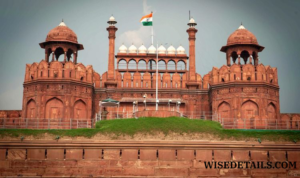
-
Mughal Architecture: The Red Fort was commissioned by the Mughal Emperor Shah Jahan in 1638 and took around a decade to complete. It is an excellent example of Mughal architecture, characterized by its red sandstone walls and intricate white marble decorations.
-
UNESCO World Heritage Site: The Red Fort was designated as a UNESCO World Heritage Site in 2007 for its cultural and historical importance. It is considered a masterpiece of Mughal architecture and an outstanding symbol of India’s rich heritage.
-
Layout and Design: The fort complex covers a vast area and is surrounded by high walls that stretch for about 2.5 kilometers (1.5 miles). It houses numerous palaces, gardens, halls, and other structures.
-
Lahore Gate: The main entrance to the Red Fort is through the impressive Lahore Gate, which faces the famed Chandni Chowk market. It is named after the city of Lahore (now in Pakistan) and gets its name from the fact that the road from this gate used to lead to Lahore.
-
Independence Day Celebrations: Every year on August 15th, India’s Independence Day, the Prime Minister hoists the national flag and addresses the nation from the Red Fort, continuing a tradition that dates back to the country’s independence in 1947.
Address: Netaji Subhash Marg, Chandni Chowk, New Delhi, Delhi 110006, India
2. Qutub Minar
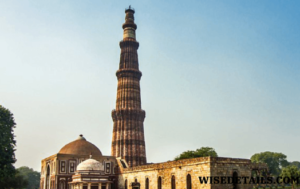
Qutub Minar is an ancient and iconic tower located in Delhi, India. It is one of the most iconic tourists attractions in the country as well as in Delhi and a UNESCO World Heritage Site. Here are some key facts about Qutub Minar:
-
Construction: The construction of Qutub Minar was started in 1192 by Qutb-ud-din Aibak, the founder of the Delhi Sultanate, and was completed by his successor Iltutmish. It was built to celebrate the victory of the Muslim rulers over the last Hindu kingdom in Delhi.
-
Architecture: Qutub Minar is a marvelous example of Indo-Islamic architecture. The tower is made of red sandstone and marble and is designed in a unique architectural style, blending elements of Persian, Turkish, and Indian craftsmanship.
-
Height: The original height of Qutub Minar was about 72.5 meters (238 feet). Over the years, it has faced some damage due to natural calamities and human activities. Presently, its height is approximately 73 meters (240 feet).
-
Structure: The tower is a five-story structure, with each floor adorned with intricate carvings and inscriptions from the Quran. The first three stories are constructed with red sandstone, while the last two stories are made of marble.
-
Iron Pillar: Near the Qutub Minar, there is a famous Iron Pillar of Delhi, which dates back to the 4th century. The pillar is known for its remarkable resistance to corrosion, despite being exposed to the elements for over a millennium.
-
Light and Sound Show: In the evenings, there is a captivating light and sound show at the Qutub Minar complex that narrates the history of the monument and the Delhi Sultanate.
Address: Mehrauli, New Delhi, Delhi 110030, India
3. India Gate
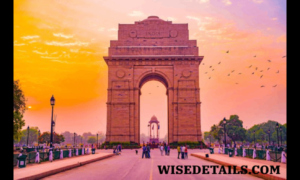
India Gate is a prominent war memorial located in the heart of New Delhi, the capital city of India. It holds deep historical and emotional significance for the country and it is one of the most iconic tourist’s attractions in Delhi. Here are some key facts about India Gate:
-
History and Purpose: India Gate was designed by Sir Edwin Lutyens, a renowned British architect, and was completed in 1931. It was originally known as the All India War Memorial and was built to honor the Indian soldiers who lost their lives during World War I and the Third Anglo-Afghan War.
-
Architectural Style: India Gate is an arch-shaped structure made of yellow sandstone. The arch is 42 meters (138 feet) high and stands on a low base with a height of 13.5 meters (44 feet). The architecture is a fusion of Indian and European styles, blending the imperial classical designs with traditional Indian elements.
-
Amar Jawan Jyoti: At the center of India Gate, there is an eternal flame known as Amar Jawan Jyoti (the Flame of the Immortal Soldier). It was added after India’s independence to pay tribute to the soldiers who sacrificed their lives during the Indo-Pakistani War of 1971.
-
Names of Soldiers: On the walls of India Gate, the names of more than 13,000 Indian and British soldiers who died during World War I and the Afghan War are inscribed. It serves as a poignant reminder of the sacrifices made by the Indian armed forces.
-
Republic Day Parade: India Gate is an integral part of the Republic Day celebrations held on January 26th each year. The President of India, along with other dignitaries, pays homage to the soldiers by laying a wreath at Amar Jawan Jyoti, and a grand military parade passes through Rajpath (the ceremonial boulevard) on this day.
Address: Rajpath, India Gate, New Delhi, Delhi, India
4. Humayun’s Tomb
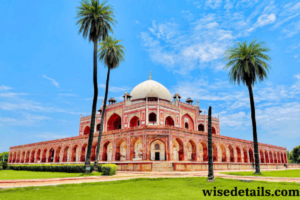
Humayun’s Tomb is a magnificent mausoleum located in Delhi, India. It is an important historical and architectural landmark, recognized as a UNESCO World Heritage Site. It is one of the most iconic tourists attractions in Delhi Here are some key facts about Humayun’s Tomb:
-
Historical Background: Humayun’s Tomb was commissioned by Humayun’s widow, Empress Bega Begum (also known as Haji Begum), after the death of the Mughal Emperor Humayun in 1556. It was completed in 1572, approximately 16 years after his death.
-
Architecture: The tomb is an outstanding example of Mughal architecture and is believed to have inspired the design of the world-famous Taj Mahal. It was designed by the Persian architect Mirak Mirza Ghiyas, who later became known as “Mirak Mirza Ghiyas Beg.”
-
Garden Setting: The tomb is located within a vast Persian-style Charbagh (four-part) garden, divided into quadrants by walkways and water channels. The garden symbolizes the idea of paradise on Earth in Islamic culture.
-
Red Sandstone and White Marble: The main structure of the tomb is constructed using red sandstone, while the elegant dome and other decorative elements are made of white marble. The combination of red sandstone and white marble gives the tomb its distinct appearance.
-
Architectural Elements: The tomb is an impressive structure with a central octagonal chamber housing Humayun’s cenotaph. The cenotaph is placed in the center of the chamber, and the actual tomb of Humayun is in the basement below.
Address – Hazrat Nizamuddin Aulia Dargah, Mathura Rd, Nizamuddin, Nizamuddin East, New Delhi, Delhi 110013, India
5. Raj Ghat
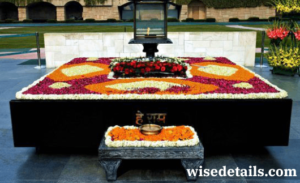
Raj Ghat is a significant memorial in Delhi, India, dedicated to Mahatma Gandhi, the father of the nation and one of the most prominent leaders of India’s independence movement. It is one of the most iconic tourists attractions in Delhi Here are some key facts about Raj Ghat:
-
Location: Raj Ghat is located on the banks of the Yamuna River in the heart of Delhi. It is a serene and peaceful spot, providing a tranquil setting for people to pay their respects to Mahatma Gandhi.
-
Memorial Platform: The memorial at Raj Ghat is a simple black marble platform that marks the spot where Mahatma Gandhi was cremated on January 31, 1948, a day after he was assassinated.
-
Symbolic Simplicity: The design of the memorial is intentionally simple and austere, in line with Gandhi’s philosophy of simple living and non-materialistic values. It represents his humility and dedication to the service of the nation.
-
Eternal Flame: An eternal flame burns at one end of the black marble platform, symbolizing the undying spirit of Mahatma Gandhi and his teachings.
-
Daily Commemoration: Raj Ghat is open to the public, and people from all walks of life visit the memorial to pay their respects and lay flowers or wreaths on the platform. There are no entry fees to visit Raj Ghat.
Address – Infront of National Defence College, 5, Tees January Marg, near Birla House, Tees January Road Area, Raj Ghat, New Delhi, Delhi 110001, India
6. Jama Masjid
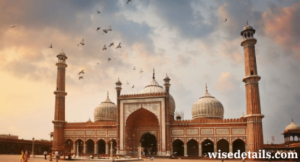
Jama Masjid is one of the largest and most important mosques in India. Located in Old Delhi, it is an architectural marvel and a significant religious and historical site. It is one of the most iconic tourists attractions in Delhi Here are some key facts about Jama Masjid:
-
Construction: Jama Masjid was commissioned by the Mughal Emperor Shah Jahan and constructed between 1644 and 1656. It was built as a symbol of Mughal grandeur and is an impressive example of Mughal architecture.
-
Architecture: Jama Masjid is made of red sandstone and white marble, with intricate carvings and architectural details. The mosque’s design is a fusion of Persian and Mughal styles, featuring three grand gateways, two towering minarets, and a large courtyard.
-
Massive Courtyard: The mosque’s courtyard can accommodate up to 25,000 worshipers at a time. It is one of the largest mosque courtyards in the world and offers a stunning view of the main prayer hall and the domes.
-
Central Prayer Hall: The main prayer hall of Jama Masjid is a large and imposing space, adorned with arches, marble domes, and a beautiful mihrab (prayer niche) that indicates the direction of Mecca.
-
Minarets: The mosque has four tall minarets, each standing at a height of about 40 meters (131 feet). Visitors can climb the minarets to enjoy panoramic views of the surrounding area.
-
Capacity and Importance: Jama Masjid is not only an important religious site for Muslims but also a significant tourist attraction and a symbol of Delhi’s historical and cultural heritage.
Jama Masjid continues to be a center of religious and cultural significance in Delhi. Its stunning architecture and rich history make it a must-visit destination for those interested in experiencing India’s Mughal heritage and exploring its diverse cultural tapestry.
Address – Opposite Chandni Chowk, Old Delhi. Near the Red Fort.
7. Akshardham Temple
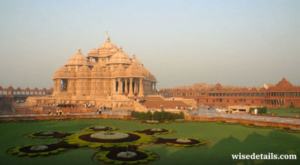
Akshardham Temple, officially known as Akshardham or Swaminarayan Akshardham Temple, is a grand Hindu temple complex located in Delhi, India. It is one of the most iconic tourists attractions in Delhi. Here are some key facts about Akshardham Temple:
-
Construction: Akshardham Temple was built by the BAPS (Bochasanwasi Shri Akshar Purushottam Swaminarayan Sanstha) organization. It was inaugurated on November 6, 2005, after years of meticulous planning and construction.
-
Architectural Marvel: The temple complex showcases an exquisite blend of traditional Indian architectural styles with modern techniques. It incorporates elements from various ancient Hindu architectural traditions, especially from Rajasthan, Gujarat, and other parts of India.
-
Main Mandir: The centerpiece of the complex is the main mandir (temple) dedicated to Bhagwan Swaminarayan. It is a five-spired structure adorned with intricate carvings and statues of deities.
-
Sahaj Anand Water Show: One of the main attractions of Akshardham is the Sahaj Anand Water Show, a multimedia show that narrates an ancient story from the Kena Upanishad. The show uses water, light, and sound effects to create a mesmerizing experience.
-
Yagnapurush Kund: The Yagnapurush Kund is a large stepwell or water reservoir with 108 sacred shrines. It is surrounded by 2,870 statues of various Hindu sages, and it serves as the venue for the Abhishek Mandap and other cultural performances.
Akshardham Temple is not only a place of worship but also an educational and cultural center that promotes Indian values, traditions, and spirituality. It attracts millions of visitors from all over the world who come to marvel at its architectural beauty and experience the essence of Indian culture and spirituality.
Address –Noida Mor, Pandav Nagar, New Delhi, Delhi, 110092, India
8. Lotus Temple
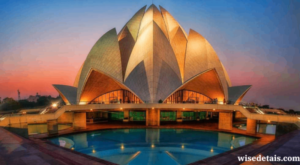
The Lotus Temple, officially known as the Bahá’í House of Worship, is a remarkable architectural marvel located in Delhi, India. It is one of the most iconic tourists attractions in Delhi. Here are some key facts about the Lotus Temple:
-
Bahá’í House of Worship: The Lotus Temple is one of the seven Bahá’í Houses of Worship around the world. It serves as a place of worship and meditation for people of all religions and backgrounds, adhering to the Bahá’í principle of unity and oneness of humanity.
-
Architectural Design: The temple’s design resembles a lotus flower, which is a sacred symbol in various religions and cultures. It was designed by the Iranian-Canadian architect Fariborz Sahba and completed in 1986.
-
Lotus Petals: The temple is made up of 27 free-standing marble-clad “petals” arranged in clusters to form the lotus shape. The petals are made of concrete and clad with white Greek Pentelicon marble, giving the temple its pristine and stunning appearance.
-
Worship Space: The central hall of the Lotus Temple is a vast and open space without any religious symbols, statues, or images. It is designed to create an atmosphere of serenity and silence for meditation and prayer.
-
Award-Winning Architecture: The unique and awe-inspiring design of the Lotus Temple has earned numerous architectural awards and recognition, making it a remarkable landmark in Delhi’s architectural landscape.
The Lotus Temple stands as a symbol of peace, harmony, and unity among all people and religions. Its unique and inclusive architecture, combined with its spiritual ambiance, makes it a cherished place for seekers of peace and tranquility in the bustling city of Delhi.
Address – Lotus Temple Rd Bahapur, Shambhu Dayal Bagh, Kalkaji, New Delhi, Delhi 110019, India
9. Chandni Chowk
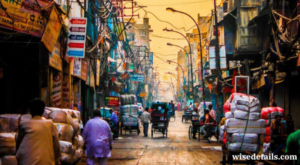
Chandni Chowk is one of the oldest and busiest marketplaces in Delhi, India. It is a vibrant and chaotic area that has been the heart of the city for centuries. It is one of the most iconic tourists attractions in Delhi. Here are some key facts about Chandni Chowk:
-
Historical Significance: Chandni Chowk was established in the 17th century by the Mughal Emperor Shah Jahan when he shifted his capital from Agra to Delhi. It was designed as a central street lined with shops and markets, and it served as the main street of the walled city of Shahjahanabad (now Old Delhi).
-
Name Origin: The name “Chandni Chowk” translates to “Moonlight Square” or “Moonlight Market.” It is believed that the market was designed to glitter like a moonlit night, with its polished marble and water-filled canals.
-
Architecture: Chandni Chowk’s architecture reflects a mix of Mughal, Persian, and Indian styles. Over the centuries, the area has seen many buildings and structures being added or rebuilt, showcasing a fascinating blend of historical and modern architecture.
-
Street Food Paradise: Chandni Chowk is renowned for its mouthwatering street food. From spicy chaats and delicious parathas to sweets like jalebi and rabri, the area offers a diverse range of delectable treats that draw food enthusiasts from all over.
-
Market and Bazaars: Chandni Chowk is a bustling marketplace where you can find almost anything, from textiles, jewelry, and electronics to spices, books, and stationery. The market is divided into different bazaars, each specializing in specific goods.
-
Metro Connectivity: To ease transportation and decongest the area, Chandni Chowk is now accessible by the Delhi Metro, making it more convenient for visitors to explore this historic market.
Chandni Chowk remains a captivating and essential part of Delhi’s cultural fabric. Its rich history, bustling markets, and diverse culinary offerings make it a must-visit destination for travelers and a favorite spot for locals seeking to experience the charm and energy of Old Delhi.
Address – 16, Gali Kababian, Jama Masjid, Old Delhi, Delhi, 110006, India
10. National Museum
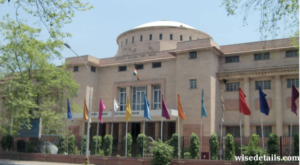
The National Museum in Delhi, India, is one of the most prominent and largest museums in the country. It is an essential institution for preserving and showcasing India’s rich cultural and historical heritage. It is one of the most iconic tourists attractions in Delhi. Here are some key facts about the National Museum:
-
Establishment: The National Museum was established on August 15, 1949, on the occasion of India’s first Independence Day. It was inaugurated by then Prime Minister Jawaharlal Nehru.
-
Location: The museum is located in New Delhi, close to the India Gate and other important landmarks. It is situated on Janpath, at the corner of Maulana Azad Road.
-
Collection: The National Museum houses a vast and diverse collection of over 200,000 works of art, artifacts, and antiquities. The collection covers a wide range of subjects, including art, archaeology, anthropology, and more.
-
Artifacts and Galleries: The museum’s exhibits are divided into various galleries, showcasing art and artifacts from different periods of Indian history, including the Indus Valley Civilization, Mauryan, Gupta, Chola, and Mughal periods.
-
Sculptures: The National Museum is known for its impressive collection of ancient sculptures, including intricate stone and bronze sculptures from various regions of India.
The National Museum plays a crucial role in preserving and promoting India’s diverse cultural heritage. It serves as an important educational resource and a treasure trove of knowledge for scholars, historians, and art enthusiasts interested in exploring India’s past and artistic traditions.
Address – National Museum Janpath, Rajpath Area, Central Secretariat, New Delhi, Delhi 110011 India.




